Sickle-leaf wattle, Pindan wattle
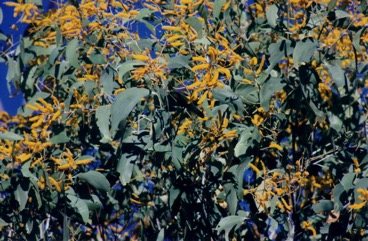
It occurs in northern Australia. It is often along stream banks. It needs a sunny position. The soil needs to be well drained. It benefits by watering in dry periods. It is grown in the Sahel in Africa. It can grow in arid places.
Also known as:
Pindon wattle, Spear wattle, Walgali, Wongai, Wongayi
Edible Portion
- Seeds, Gum
Where does Sickle-leaf wattle grow?
Found in: Australia, East Africa, Kenya, Sahel
Notes: There are about 1,350 Acacia species. Over 1,000 occur in Australia. Also as Mimosaceae.
Growing Sickle-leaf wattle, Pindan wattle
Cultivation: It is grown from seed. It can be cultivated by root suckers.
Edible Uses: The young pods are steamed and the seeds eaten. (The seeds cause flatulence and bad breath.) The seeds especially the mature seeds may contain some poisonous substance. Their use as food is disputed in some areas. In some areas the mature seeds are pounded into flour mixed with water and eaten as a paste. The gum is eaten.
Production: It is a fast growing plant. Flowering occurs in Australia from April to August and fruiting from September to October.
Nutrition Info
per 100g edible portion| Edible Part | Energy (kcal) | Protein (g) | Iron (mg) | Vitamin A (ug) | Vitamin c (mg) | Zinc (mg) | % Water |
|---|---|---|---|---|---|---|---|
| Seeds | - | - | - | - | - | - | |
| Gum | - | - | - | - | - | - |
Sickle-leaf wattle, Pindan wattle Photos

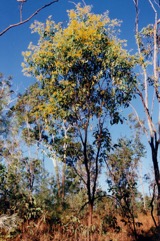
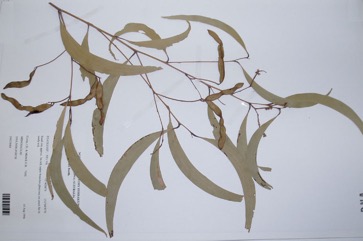
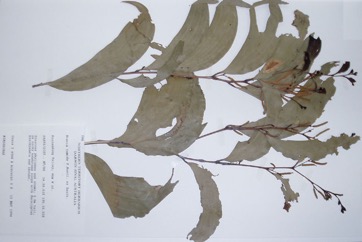
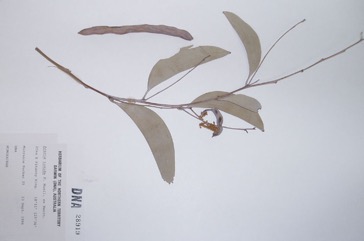
References
Bindon, P., 1996, Useful Bush Plants. Western Australian Museum. p 30
Cancilla, D., 2018, Ethnobotanical and Ethnozoological Values Desktop Assessment - Eliwana Project. p 40
Cherikoff V. & Isaacs, J., The Bush Food Handbook. How to gather, grow, process and cook Australian Wild Foods. Ti Tree Press, Australia p 42, 188
Crawford, I. M., 1982, Traditional Aboriginal Plant Resources in the Kalumburu Area: Aspects in Ethno-economics. Records of the Western Australian Museum Supplement No. 15
Doran, J.C., & Turnbull, J.W. (Eds), 1997, Australian Trees and Shrubs: species for land rehabilitation and farm plantings in the tropics. ACIAR Monograph No 24. p 234
Elliot, W.R., & Jones, D.L., 1982, Encyclopedia of Australian Plants suitable for cultivation. Vol 2. Lothian. p 125
Fl. austral. 2:409. 1864
Flora of Australia Volume 11A, Mimosaceae, Acacia part 1. Melbourne: ABRS/CSIRO, 2001, p 32
ILDIS Legumes of the World http:www;ildis.org/Legume/Web
Kenneally, K.E., Edinger, D. C., and Willing T., 1996, Broome and Beyond, Plants and People of the Dampier Peninsula, Kimberley, Western Australia. Department of Conservation and Land Management. p 134
Lazarides, M. & Hince, B., 1993, Handbook of Economic Plants of Australia, CSIRO. p 7
Paczkowska, G . & Chapman, A.R., 2000, The Western Australian Flora. A Descriptive Catalogue. Western Australian Herbarium. p 327
Pennock, A., et al, Australian Dry-zone Acacias for Human Food: Proceedings of a Workshop.
Petheram, R.J. and Kok, B., 2003, Plants of the Kimberley Region of Western Australia. UWA Press p 369
Smith, M & Kalotas, A. C., 1985, Bardi Plants: An Annotated List of Plants and Their Use by the Bardi Aborigines of Dampierland, in North-western Australia. Rec. West Aust. Mus. 1985, 12(3): 317-359
Vigilante, T., et al, 2013, Island country: Aboriginal connections, values and knowledge of the Western Kimberley islands in the context of an island biological survey. Records of the Western Australian Museum Supplement 81: 145-182
Wheeler, J.R.(ed.), 1992, Flora of the Kimberley Region. CALM, Western Australian Herbarium, p 330